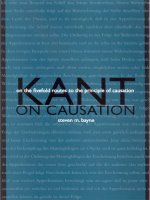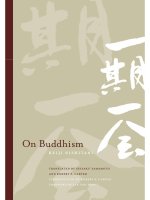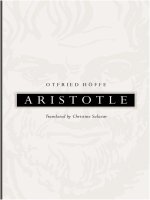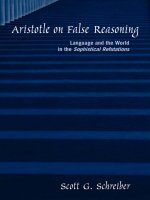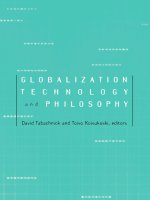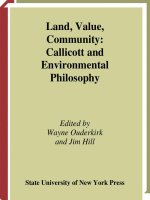state university of new york press the evolution of death why we are living longer oct 2006
Bạn đang xem bản rút gọn của tài liệu. Xem và tải ngay bản đầy đủ của tài liệu tại đây (2.6 MB, 261 trang )
why we are living longer
stanley shostak
the evolution of death
THE EVOLUTION OF DEATH
SUNY Series in Philosophy and Biology
David Edward Shaner, editor
the evolution of death
why we are living longer
stanley shostak
STATE UNIVERSITY OF NEW YORK PRESS
Published by
State University of New York Press, Albany
© 2006 State University of New York
All rights reserved
Printed in the United States of America
No part of this book may be used or reproduced
in any manner whatsoever without written permission.
No part of this book may be stored in a retrieval system
or transmitted in any form or by any means including
electronic, electrostatic, magnetic tape, mechanical,
photocopying, recording, or otherwise without the prior
permission in writing of the publisher.
For information, address State University of New York Press,
194 Washington Avenue, Suite 305, Albany, NY 12210-2384
Production by Marilyn P. Semerad
Marketing by Susan M. Petrie
Library of Congress Cataloging in Publication Data
Shostak, Stanley.
The evolution of death : why we are living longer / Stanley Shostak.
p. ; cm. — (SUNY series in philosophy and biology)
Includes bibliographical references and index.
ISBN-13: 978-0-7914-6945-3 (hardcover : alk. paper)
ISBN-10: 0-7914-6945-X (hardcover : alk. paper)
ISBN-13: 978-0-7914-6946-0 (pbk. : alk. paper)
ISBN-10: 0-7914-6946-8 (pbk. : alk. paper) 1. Death. 2. Aging. 3.
Life expectancy.
[DNLM: 1. Death. 2. Aging. 3. Evolution. 4. Life
Expectancy—trends. WT 116 S559e 2006] I. Title. II. Series.
QP87.S43 2006
613.2—dc22
2005037275
10 9 8 7 6 5 4 3 2 1
To A. B. and G. P.
This page intentionally left blank.
Contents
List of Illustrations ix
Preface xi
Introduction: Death the Mystery 1
Part I. How Biology Makes Sense of Death 5
1. Evolution: Death’s Unifying Principle 7
Death Evolves! 7
False Clues: Where Science Got It Wrong 9
In Sum 39
2. Charting Death’s Evolution and Life’s Extension 41
Measuring Death’s Evolution: Empirical Evidence 42
Modeling the Evolution of Lifetimes 48
Accommodating Increased Longevity 51
In Sum 55
3. Rethinking Lifecycles and Arrows 57
Life as a Cycle: Lifecycles Connect Life to Life 58
Adaptations to Lifecycles 71
The Linear View of Life: Life’s Arrow 75
What Is Wrong with the Weismann/Haeckel Doctrine79
In Sum 85
4. Keeping Life Afloat 89
Why Is Life So Profligate? 90
Gambling on Life: Death against the Odds 95
vii
Improving Profit Margins 100
In Sum 104
Part II. How Death Evolves and Where It Is Heading 105
5. Putting Cells in the Picture 107
Cellular Theories of Life and Death 107
The Cell’s Role in Growth and Development 109
The Cell’s Role in Maintenance and Regeneration of Adult Tissues 112
The Cell’s Role in Death 117
The Cell’s Potential Role in Regeneration Therapy 121
In Sum 130
6. Neoteny and Longevity 133
The Time Is Out of Joint 134
Juvenile Life Expectancy Spreads Upward 136
Neoteny and the Germ Line 142
Fecundity Is Decreasing 144
In Sum 148
Afterword 151
How Death’s Evolution Escaped the Gerontologist’s Notice 152
Where Will Death’s Evolution Take Us? 156
Appendix: Different Forms of Life and Death 161
Notes 173
Glossary 197
Bibliography 205
Index 235
viii CONTENTS
Illustrations
Figure 1.1 Survivorship distributions for comparable life spans 13
Figure 1.2 Partial disease profile for the seven stages of a lifetime 39
Figure 2.1 Death rates by age and sex in the United States, 1955–1999 44
Figure 2.2 Percentage change in death rates and age-adjusted death rates
between 1998 and 1999 by age, race, and sex, in the
United States 45
Figure 2.3 Life expectancy by sex in the United States, 1970–1999 47
Figure 2.4 Life span model 50
Figure 2.5 Life span model in action 50
Figure 2.6 The accordion model 52
Figure 2.7 The bagpipe model 53
Figure 3.1 A lifecycle, as proposed by Thomas Huxley 58
Figure 3.2 Death’s role in a lifecycle 62
Figure 3.3 The Eukaryotic lifecycle as waves 64
Figure 3.4 Stages of a life span 67
Figure 3.5 Weismann’s divide 76
Figure 3.6 Numbers of precursors, oocytes, and spermatozoa in
Homo sapiens 85
Figure 4.1 Total deaths in Singapore, 1991–2000 96
Figure 4.2 Infant mortality rates in Singapore, 1991–2000 97
Figure 4.3 Life expectancy as a function of age 98
ix
Figure 5.1 Stem and transit amplifying cell dynamics 115
Figure 6.1 More stem cells lead to longer life 141
Figure 6.2 Birth rates by age of mother in the United States,
1960–1993 145
Figure 6.3 Pregnancy rates by age of mother in the United States,
1980–1999 146
Figure 6.4 Semen quality of birth cohorts 147
xILLUSTRATIONS
Preface
The changes in expectation of life from the middle of the seventeenth cen-
tury to the present time where the records are most extensive and reliable
appear to furnish a record of a real evolutionary progression. In this respect
at least man has definitely and distinctively changed, as a race, in a period
of three and a half centuries.
—Raymond Pearl, The Biology of Death
“. . . Death is like birth, painful, messy and undignified. Most of the time
anyway.” She thought, Perhaps it’s just as well. Reminds us that we’re ani-
mals. Maybe we’d do better if we tried to behave more like good animals
and less like gods.
—P. D. James, Death in Holy Orders
Science has always been my favorite form of whodunit, especially when the
scientist discovers a tantalizing mystery and solves it with clever experiments
or observations. Regrettably, some very tantalizing mysteries remain on the
back shelf of science, never having made it to the bestseller list. Death is one
such mystery. We all know that death, like reproduction and metabolism, is a
fundamental feature of life—only living things can die—and we also know
that death is somehow inherited from generation to generation, but exactly
what death is adapted to and how it evolves are mysteries that have remained
sub-rosa. Until now!
The Evolution of Death is about to change death from a dead subject into
a vital one, burgeoning with those concepts and consequences that tradition-
ally arouse curiosity and command attention about life. The problem is that
death, like taxes (to take a page from Benjamin Franklin), is thought to be
inevitable and unchanging. Remarkably, while belief in the inevitability of
many things, such as war, poverty and crime, has slackened in the last few
years, belief in the inevitability of death has remained unshaken. Continents
have been seen to move, the appearance and disappearance of oceans has been
acknowledged, and even stars have waxed and waned, but the immutability of
death continues to ride the storm. Well, no more!
xi
In fact, registries and census data have recorded evidence of death’s evo-
lution for centuries, but hardly anyone took notice. These data were and are
fobbed off as consequences of improvements in lifestyle brought about
through agriculture, industrial, technological and informational revolutions,
and modern, urban living. But these same data also testify to death’s progress
toward aptness, downstream in the flow of life. In fact, the mystery solved
here is whether the human form of death has been evolving for millennia,
inexorably achieving greater refinement, efficiency, and cost effectiveness.
Fundamentally, death is the process of making corpses from living things.
Hence, death evolves by making corpses better—making corpses more easily,
more efficiently, and with less disruption to life, which is to say, corpses that
waste less of life’s precious material than in the past. Death thus feeds back
onto life, turning the body into a corpse only after life is exhausted. Because
evolution supplies new and improved models of death, life is becoming
longer, fuller, and healthier.
The Evolution of Death traces these improvements in death to changes in
the life cycle: by lubricating life’s cycle, death greases the way to better life.
Moreover, life cycles with the best lubrication shape future generations. If the
expansion of the human lifespan continues at its present rate or accelerates, as
some gerontologists predict,
1
we may very well live indefinitely, and death
will truly have died.
But before I abandon the present generation to its untimely fate, allow me
to express my profound gratitude for the help I’ve had writing this book. Truly,
if I acknowledged all the sources I have gathered beyond those cited, I would
add unconscionably to the length of this preface. Possibly the greatest luxury
available to academics is the leisure to wade through the literature until the
source of ones “own” idea is found, and the literature on aging and mortality
is, if nothing else, one of ideas. I am, indeed, in debt to and in awe of the early
aging theorists and can only hope that The Evolution of Death is an appropri-
ate tribute to them. Beyond this general acknowledgment, however, I will let
them rest in peace.
My more immediate and pressing debts are to the living. Drynda Johnson,
head librarian at the Langley Lending Library, University of Pittsburgh, and
her assistants, Laura McVey and Ann Rogers, performed yeoman service get-
ting me every book and article I requested, no matter how remote the source
or esoteric the subject. Thanks!
I would be shamefully guilty of neglect were I to fail to mention members
of Los Angeles’Gerontology Research Group who attended my lecture in Feb-
ruary 2003 and offered much needed and appreciated criticism through corre-
spondence. In particular, I am indebted to L. Stephen Coles, M.D., Ph.D. who
read Chapter 1 and provided criticism when it was urgently needed, and to
Karlis Ullis, M.D. who provided lavish hospitality and profound analysis
during my stay in Los Angeles. Thanks again!
xii PREFACE
I would be remiss were I not to thank my acquisition editor, Jane Bunker
of the State University of New York Press, who shepherded the manuscript
through many a rough spot. May I add my gratitude to my two anonymous
readers who managed to find helpful things to say amidst their criticisms. And
may I add my thanks to Robert Olby, my friend and critic, who read and
guided me through history in several chapters.
I am also grateful to my son, Daniel Shostak, who worked with me on
applying the chronic disease model to life. In fact, it was Dan who made the
model work for pies and doughnuts, accordions and bagpipes!
Finally, Marcia Landy, Distinguished Service Professor and film scholar,
is my first reader of record and my best and wisest critic. Her innumerable
readings of the manuscript for this book, I confess, made it the book that it is
today. I could not have had a better, kinder, gentler friend. No amount of
thanks is sufficient, but I keep trying.
Preface xiii
This page intentionally left blank.
Introduction:
Death the Mystery
Human beings are near-perfect animals. Of course, we might be improved
with a few minor adjustments—strengthening the back for lifting and bearing
in an upright posture, broadening hips for ease and safety of childbirth
1
—but,
with one major exception, we are exquisitely adapted to our way of life: to sur-
vival and reproduction in our terrestrial habitat and agricultural-mechanized-
technological ecological niche. Like our mammalian relatives, adult human
females provide an excellent womb for gestation and the capacity to nurture
offspring with milk of high nutritional quality. Like our primate cousins,
human beings have reasonably good color discrimination, stereoscopic vision,
sense of balance and acceleration, and adequate olfaction. We also have
opposable thumbs, dexterous hands, a bipedal gait, and an immense brain
capable of virtually infinite learning and inspired thinking.
Our major flaw is death:
2
We “die like dogs” (or animals generally).
Death, which is to say, irreversible damage to the chemistry of life,
3
is the
greatest affront to human dignity, especially death accompanying aging. What
I have in mind is death due to senescence and decrepitude, the ultimate killers,
as opposed to the forms of death that will always be with us—death due to
trauma, war, overwork, famine, and infectious disease. Why are we cut off by
age, left to decline instead of prosper in our prime? Why are we rendered help-
less by senescence? Why are we consigned to intolerable fear, subject to use-
less pain, and made virtually vegetative in our old age? Indeed, why do
“changes occur in a human being from 30 to 70 to increase the chance of dying
by roughly 32 fold”?
4
WHY DO WE DIE?
All these questions smack of mystery, and many mystifying answers have
been proposed over the millennia. Some answers, while not incontrovertible
and definitive, seem to serve one purpose or another. Answers may take the
1
form of myths and serve a variety of cultural functions, although they do not
deal with death materially. Other answers pose scientific explanations and
serve the legitimate interests of the science establishment, governmental
health agencies, and pharmaceutical, insurance, and health care industries
without explaining death fundamentally. One may wonder if “why” is the
right question.
First of all, answers to why questions proposed by scientists concerned
with the laws of nature and physicians concerned with the nitty-gritty of health
care tend to stream off to remote and impersonal causes. Death, on the other
hand, is very proximate and personal. Ultimately, answers to fundamental
questions should include material causes, and answers to materialist questions
must also bear fundamental causes. What is required is a joining of funda-
mental causes and material causality in a unified principle—finding a thread
as well as a needle to stitch answers together into a unified concept of death.
Secondly, answers offered by the man on the street and by religious and
philosophical thinkers frequently vanish at the far end of relevance. These
answers range from clichés to the esoteric, from slogans on bumper stickers to
occult arcana and from sacred doctrine to scientific dogma. No wonder
answers have been debated for millennia without resolution!
Casual talk in the barroom, and bedroom about why we die seems broadly
unfocused, clouded by confusion, and shaded by mystery. Of course, answers
that instill fear or terror of pain or of the beyond may be intended to deter sui-
cide in those in despair or in agony without answering the question. Other-
wise, to say “We die because we are born” reveals a primitive fatalism, and to
suggest “We die because it’s normal” exposes a pessimistic determinism. Such
statements may even have the ring of objectivity, scientific reductionism, and
statistical predictability, but neither birth nor bell-shaped curves cause death
in any direct way.
Theologians tell us that we die for any number of reasons, but generally
because the human soul or spirit “has a life of its own,” an immortal life, as
the case may be, and cannot be tied down to a mortal body. As reflected in the
thought of great philosophers around the world and throughout the ages, the
human soul is considered the nature of being, an active principle of life, of
consciousness, conscience, justice, truth, joy, affection, tenderness, cherishing,
and love. Thus we die because the departure of this soul deprives us of every-
thing recognizable about human life.
Death is merely the gateway of the immortal soul to eternity. We die
because the soul must move on while the body returns to dust. We die to
permit the eternal spirit to reach its potential, its emancipation and ascendance.
Or we die for less elevated reasons: because one is rewarded or punished for
how one has lived (“For the wages of sinne is death”
5
); because God con-
demned us to die after Adam and Eve sinned in the Garden; and so on.
2INTRODUCTION: DEATH THE MYSTERY
In addition, the notion that the soul or spirit can survive separation from
the body while leaving a corpse behind may relieve the bereaved of anxiety,
provide survivors with rationales that calm and cajole, and coerce the despon-
dent back from the abyss to their place in society and to useful employment.
But souls have never been seen leaving bodies no matter whose cemetery one
visits or how deeply one digs. The question is, can the departure of anything
so immaterial as a soul explain anything so material as a corpse?
Saying that death is caused by the departure of a living principle from the
body would seem more circular than causal. What is more, various bodies,
such as those of animals, may live without souls or spirits, although one may
reserve the possibility that pets and some domesticated animals have souls.
Indeed, even some human beings are said to exist without a soul or spirit—at
least as testified by fairy tales and mythologies of wood nymphs and water
goblins, to say nothing about horror and fantasy novels, grade B movies, and
comic books featuring zombies, vampires, and the “living dead.” Such sprites
may not be truly human, however, since they are incapable of the human pas-
sion for truth, if not for beauty.
But let us bend over backwards to make the case for the departure of a
soul as the material cause of death. Let us imagine that the Grim Reaper,
Angel of Death, Avenging Angel, or Winged Chariot is really an effector of
the material transformation of body to corpse. Thus, as the effector liberates
or takes possession of the soul, the body turns into a purely material corpse
on the verge of returning to dust.
6
Is such an effector a legitimate or an unnec-
essary hypothesis?
Much of what has been learned through the scientific study of death sug-
gests that death is amply correlated with material causes, but nothing whatso-
ever would seem to prevent a transcendent effector from using these same
causes while turning an organism into a corpse, and one is loath to tell a tran-
scendent effector how to operate. Thus, the issue here is not one of mecha-
nism—how the power over life and death is exercised—but where that power
rests. On the one hand, material causality operates blindly, while, on the other
hand, a transcendent effector has discretion. Under the aegis of material
causes, the same conditions bring about the same end, while decisions over
life and death by a transcendental effector could be cogent and might even be
subject to approval by higher authority.
The burden for demonstrating a role for a transcendent effector in life and
death decisions, therefore, would seem to rest on how much discretion is at the
effector’s disposal. Indeed, prophets, eager to demonstrate God’s mercy, have
claimed to have intervened successfully on behalf of those threatened with
death, and much religious ceremony, rite, and ritual is devoted to repealing
God’s fatal sentence. Certainly, the God “that didst dye for me”
7
epitomizes
the possibility of discretionary power over life and death.
Introduction: Death the Mystery 3
But can one parry the effector’s fatal thrust? Can I truly “lay me down and
dee” for bonnie Annie Lawrie?
8
Can soldiers die in the place of their leaders;
can martyrs die in the place of their followers? Or, to reverse the field, can vic-
tims and scapegoats effectively condemn their persecutors to death? For the
most part, substitution does not seem an available option no matter how fer-
vent the appeal or justified the claim. Death does not seem to be the cipher,
and a transcendent effector does not seem to be the decipherer. But other pos-
sibilities remain.
Another point at which transcendence might work causally occurs when
deities or gods decide to interfere in the affairs of mortals. We are told, for
example, “As Flies to wanton Boyes are we to th’ Gods, / They kill vs for their
sport.”
9
These interlopers are higher powers that cannot be questioned or held
accountable, however, and, thus we cannot hope to learn anything about
causality from them.
Philosophers may be more sympathetic than theologians to the desire to
explain death materially, but philosophers are not necessarily more successful.
Jacques Derrida, the late deconstructionist philosopher of being, suggests that
death, like history, must remain a mystery, even in light of the excess of
knowledge and detail presently surrounding it. “Philosophy . . . is nothing
other than this vigil over death that watches out for death and watches over
death, as if over the very life of the soul.”
10
For Derrida, the question is not
one of adaptation but whether mortal human beings can acknowledge death.
“[T]o have the experience of one’s absolute singularity and apprehend one’s
own death, amounts to the same thing.”
11
But “singularity” can be the impor-
tance, significance or meaning of death without explaining it.
Thomas Nagel, the philosopher of problems, intuition, and discord, on the
other hand, has acknowledged death without acknowledging singularity.
Building on Epicurus’ notion of death as the end of sensation and awareness,
Nagel extends “‘death’ . . . to mean permanent death, unsupplemented by any
form of conscious survival.”
12
Death is thus the making of corpses, turning a
living thing into something “dead as a doornail,” and that would seem to be as
far as philosophical discourse can go. Thus, materiality and causality cannot
be integrated in the philosopher’s calculus but the dead can be specified.
The picture emerging here is beginning to be complex and detailed
enough—the haystack is taking shape—but what is the thread and what is the
needle? Let me hint broadly: is the thread life and is the needle evolution?
4INTRODUCTION: DEATH THE MYSTERY
Part I
How Biology Makes Sense of Death
In the past, death posed a conundrum for biologists: death as such did not seem
to perform a function in life, yet death seemed a part of life, since only living
things died. Indeed, death did not seem to be one of life’s qualities, even
though, with few exceptions, it was the end of life. Likewise, death seemed
incapable of evolving, since it did not contribute to the fitness of the individ-
ual, and genes would not, therefore, determine death.
Part 1 reexamines these premises. If death is part of life, it must take part
in life, but how? Chapter 1 emphasizes evolution as the principle that unifies
death with life while dismissing some of the false clues that have misled sci-
entists in their quest to make sense of death. Chapter 2 cuts to the chase: if
death is part of life, then death must evolve, and, indeed, it does! The chapter
goes on to use a chronic disease model of survival to examine two possibili-
ties for lifetime expansion: the accordion and bagpipe models. Only the exten-
sion of life’s juvenile stage makes sense when tested. Chapters 3 and 4 raise
the stakes, finding death’s place in the context of life’s complexity, lifecycles
(chapter 3), and life’s far-from-equilibrium thermodynamics and statistical
dynamics (chapter 4). Lifecycles connect life to life, while death smoothes the
flow between them and lengthens the life span through evolution. Death is not
the waste of life it sometimes seems, but the pathway through which energy
flows through virtual life and through its fractals.
5
This page intentionally left blank.
Chapter 1
Evolution: Death’s Unifying Principle
We should also recall, as if we needed reminding, that we are mortal and
limited, and thus should remember that the old myths of unrestricted
curiosity and the corruption of power are not necessarily fables.
—Simon Conway Morris, Life’s Solution:
Inevitable Humans in a Lonely Universe
Normality seems to have nothing to do with it, for the fact that we will all
inevitably die in a few score years cannot by itself imply that it would not
be good to live longer.
—Thomas Nagel, Mortal Questions
The machine, mon ami, wears out. One cannot, alas, install the new engine
and continue to run as before like a motor car.
—Agatha Christie, Curtain: Hercule Poirot’s Last and Greatest Case
All living things have their own ways of dying or not. I describe these ways in
the appendix, but The Evolution of Death is primarily concerned with death in
Homo sapiens—our death. If we are ever to understand death, it will be
because we see it as part of life—as evolving. Science got it wrong several
times in the past, but the consequences of death’s resuscitation, its reinstalla-
tion in life, for culture and civilization will be enormous.
DEATH EVOLVES!
In the last few hundred years, human beings have created an environment in
which death has been delayed as a result of all sorts of improvements:
7
sanitation, nutrition, medicine, and so on. Those who most profited from
these changes have lived to tell the tale. And their survival and reproduction
has shaped the evolution of our death. Consequently, individuals remain
young longer and delay aging to their later years. Indeed, so-called natural or
age-dependent human death now comes later than at any time in the past.
One struggles vainly to isolate a single cause of death’s evolution. For
example, levels of dietary sodium and genes both influence each of the age-
related biological measures of declining cardiac function, including heart rate,
blood pressure, and arterial stiffness. Effects of environmental and genetic fac-
tors on aging, dying, and death may be indistinguishable, and particular envi-
ronments seem to produce phenocopies (that is, environmentally induced
mimics of mutations). For example, in model systems, the effects of caloric
restriction on enhancing longevity are identical to single gene mutations that
increase life span from 30 percent to a doubling or more.
1
The environmental
effect set off by reducing the number of calories in the diet converges with the
effect of genes encoding members of the insulin-like glucose-metabolism
pathway. Like life, death is a facet of underlying continuity, endlessly moving
and evolving.
The scale of death’s recent evolution is also difficult to grasp, and accept-
ing it may require a thorough reorientation toward life. Instead of imagining
death as the antithesis of life, death must be appreciated as an evolving part of
life and an adaptation to life. Life must also be seen differently, namely, as
incorporating the various aspects of death, such as exchange, feedback,
turnover, and regulation. Indeed, death’s major features, it turns out, create life
as we know it, and even make life possible!
One might think, naively, isn’t it ironic that death has evolved toward the
accumulation of resources, the prolongation of youth, and the extension of
life in succeeding generations? But the irony disappears upon reflection.
When we die of old age, it is not because we have failed prematurely to uti-
lize our inborn resources. Those resources—in particular, our stem cells—are
invested throughout our lifetime. We die because these resources are
exhausted. We die because hardly anything remains (for example, of our
stem-cell populations) capable of supporting further life. But the downstream
movement of death is a direct consequence of our upstream addition of
resources that prolong youthfulness and hence life. In the future, as long as
we continue to shape our ecological niche toward longevity, human beings
will be born with greater and greater resources and hence increased longevity.
It is widely acknowledged that human beings are generally living longer
today than ever before, but death will continue to optimize, and as it
approaches its apotheosis, death will all but disappear!
Chance, of course, also enters the equation of life,
2
in the sense of reac-
tions that are probabilistic as opposed to deterministic, and constraints on
intrinsically stochastic fluctuation and feedback rather than mere alternate
8HOW BIOLOGY MAKES SENSE OF DEATH
pathways and unspecified ranges of variation. Hence chance, along with the
environment and genes, enters equations for the accumulation and availability
of resources, accounting for the variability of life span.
Thus, death is a part of life. Death evolves when living things accumulate
resources, when genes and other hereditary influences provide the pathways
that make those resources available, the environment makes them accessible,
and chance decides whether or not a resource will be there when needed.
Death is subject to natural selection, changing over generations under the aus-
pices of contingency and opportunity. By coming later in life, after the exhaus-
tion of resources, death exhibits the exquisite integration of structure and
function peculiar to life. And, hence, death is adaptive. Through its evolution,
death increases fitness, emerging from and enhancing reproduction, like other
aspects of life. Indeed, we still die, but evolution has made death operate more
efficiently and economically than at any time in the past—and death is still
evolving.
FALSE CLUES: WHERE SCIENCE GOT IT WRONG
Scientists function to provide worldly solutions to problems and favor num-
bers and equations over mere words. And scientists are supposed to be suffi-
ciently disinterested when it comes to death to perform their function.
The Nobel Prize–winning zoologist/immunologist and author, Peter
Medawar, for example, had no truck with terms pirated from the vernacular,
insisting instead on a working understanding. From his vantage point, the
terms “life” and “death” “used in scientific contexts [were] far removed from
those [contexts] that might arise in common speech . . . [such as] whether the
condition of the possible [organ] donor is reversible or not.”
3
But even scien-
tists willing to take on eternal verities frame aging, dying, and death within a
canonical mold: we die because living things have always died.
4
Thus, we die
at the behest of statistics, of a species’ finite life span, of killer genes, killer
environments, or entropy and the laws of thermodynamics. But do we?
Chapter 1 examines the objectivity of these scientific truths. Several ques-
tions are raised in the form of “Do we die at the whim (command, behest)
of ?” But to all these questions, the answer is resolutely no. The rejection
of these “objective” possibilities ultimately places death on its one firm basis,
namely, life.
DO WE DIE AT THE WHIM OF STATISTICS?
Thomas Robert Malthus (1766–1834) should be credited with making an early
effort to put a scientific face on the statistics of death. His 1798 An Essay on
Evolution 9
the Principle of Population (largely a polemic on the necessity for appropria-
tion and uneven distribution of wealth, a diatribe against Mr. Pitt’s Poor Laws,
the parish system, and enclosure of the commons, and a mocking critique of
notions of physical immortality) argued “that the power of population is indef-
initely greater than the power in the earth to produce subsistence for man,” and
“in no state that we have yet known has the power of population been left to
exert itself with perfect freedom.”
5
Therefore, populations are held in check,
frequently, but not necessarily, at their subsistence level. According to
Malthus, human populations are constrained both positively (preventively),
for example, by marriage, virtue, and other moral constraints, and negatively
(destructively), for example, by contraception, abortion (“improper arts to
conceal”
6
), and premature death. Specifically, the “lower classes . . . suffer
from the want of proper and sufficient food, from hard labour and unwhole-
some habitations . . . [to which] may be added vicious customs with respect to
women, great cities, unwholesome manufactures, luxury, pestilence, and
war.”
7
Later, in A Summary View of the Principle of Population, Malthus
added to the list of negatives the “whole train of common diseases and epi-
demics . . . infanticide, plague and famine.”
8
Charles Robert Darwin (1809–1882) “happened to read for amusement
Malthus on Population, and being well prepared to appreciate the struggle for
existence which everywhere goes on . . . [was] at once struck . . . that under
these circumstances favourable variation would tend to be preserved, and
unfavourable ones to be destroyed.”
9
Alfred Russel Wallace (1823–1913), the
“other” discoverer of natural selection, admits to a similar “coincidence.”
10
But candor aside, Darwin and Wallace were compelled to acknowledge their
debt to Malthus if only because his pamphlet was widely read. His doctrine
might also have been broadly accepted in Britain, if not elsewhere, as Daniel
Todes points out: “[I]t would not be surprising if Darwin’s contemporaries,
especially those outside of the British cultural context, associated his struggle
for existence with specifically British, bourgeois, or Malthusian values.”
11
Of course, Darwin and Wallace were less interested in what kept popula-
tions in check than in what unleashed the origin of new species. Thus, Dar-
winism took Malthus’s notion of negative checks onestep further, implying
that some organisms were selectively squeezed out or killed while others sur-
vived because of their advantageous morphology. Pasted together, Malthusian
constraints and Darwinian selection became, in essence, a theory of death cre-
ating room at the top, or space for the evolution of improved species. But is
this synthesis incontrovertible?
Were death to serve the evolutionary function of creating wiggle room for
favorable variants, aging and dying would be especially advantageous in
species confronting complex and changing environments simply because the
survival of these species might depend on variant organisms that happen to be
better adapted to new circumstance than run-of-the-mill organisms. Indeed,
10 HOW BIOLOGY MAKES SENSE OF DEATH


